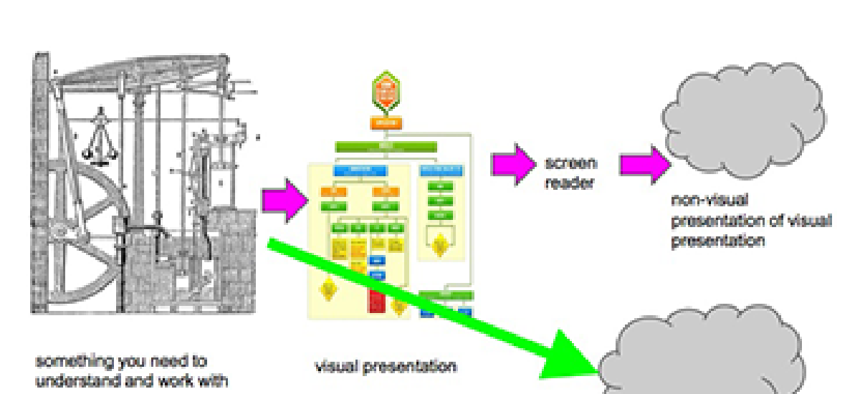Moving beyond the screen reader in 508 compliance

To make visual data accessible to the visually-impaired, try starting from scratch.

A slide from Clayton Lewis' presentation diagrams two routes to making information non-visual.
The approach to making websites accessible for people who are blind or visually impaired must go beyond the screen reader paradigm that relies on translating visual aspects of the web, Professor Clayton Lewis said at the Federal Communications Commission on July 16.
Lewis, a professor of computer science at the University of Colorado and keynote speaker at the FCC's event on accessibility and innovation, credited this idea to Google computer scientist and accessibility specialist T.V. Raman.
"Our normal paradigm is to say, well if you can't see that visual representation, we'll give you a screen reader, and what the screen reader will do is in effect translate that visual presentation into some non-visual presentation that you're able to work with," Lewis said.
There is another approach, he said: Bypass the visual presentation entirely, consider the information in its raw conceptual terms and find another way to convey it.
"We think of accessibility in terms of providing access to that visual presentation,” Lewis said. “What Raman's arguing is we shouldn't do that. We should be thinking about how to provide access to the underlying activity."
Section 508 of the Rehabilitation Act requires agencies to make presentations accessible. But in the age of application program interfaces, agencies put more of their focus on supplying the data that enables others to make presentations, Lewis said.
He pointed to the Blue Button App that Veterans Affairs uses for health records as an example of an agency disseminating raw data and having other organizations write client programs to display it.
"Arguably our communication would be better if we oriented ourselves towards [the question of] what is the content we're actually trying to convey, as opposed to what's the visual effect I'm trying to create," he said.
Lewis said that seeing code as bodies of computational units instead of bodies of text is an example of bypassing visual bias.
"The very way we describe visual programing is as if it was inherently visual, but the Raman principle says nothing is inherently visual," he said. "The conceptual benefit can't be tied to the visuality of the experience as we think of it, but it must be tied to what's involved in understanding code," Lewis added.
NEXT STORY: Sisk becomes FAS head





